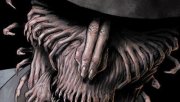Αναζήτηση στην Κοινότητα
Εμφάνιση αποτελεσμάτων για ετικέτες 'fatale'.
Βρέθηκε 2 αποτελέσματα
-
The comic medium had a lot to celebrate last weekend. Not only did Iron Man 3 usher in blockbuster season with our favorite exoskeletal superhero, but Saturday saw all of the major publishers unleash a metric ton of pro bono product on Free Comic Book Day. With all of these reminders of how fabulous the printed and digital panel can be, Paste decided to sit down and take inventory of the titles that make our Wednesday comic shop jaunts an addictive necessity. On Monday we ran through Marvel’s finest, yesterday we dove into DC’s best, and today Paste takes a look at Image’s many superlative offerings. At this point it wouldn’t be accurate to call the independent publisher a sleeping giant; with its genre-hopping line of titles produced from an A-list roster of talent, the imprint has proven that its creator-owned model is a vital component for the comic industry. It was difficult honing their selection down to ten, but here are our absolute favorites; let us know yours in the comments. 10. Witch Doctor Writer: Brandon Seifert Artist: Lukas Ketner Falling somewhere between Doctor Strange, John Constantine, and your childhood pediatrician, titular Witch Doctor Dr. Vincent Marrow treats patients afflicted with supernatural maladies using a combination of technology and magic. Brandon Seifert’s scripts redefine the mystical in nifty scientific analogies, comparing the soul to a spiritual immune system and likening demonic possession to vicious parasites. This inventive approach is married to an old-school horror aesthetic that would fit right into a Creepy anthology or Bernie Wrightson’s portfolio. Campy in all the right ways, Witch Doctor’s expansive world has unfolded in captivating and curious ways with each new miniseries, most recently in the fantastic “Mal Practice” arc. (Sean Edgar) 9. The Walking Dead Writer: Robert Kirkman Artist: Charlie Adlard You have to hand it to Robert Kirkman. Years after challenging the creative community to abandon licensed properties, Image Comics’ bearded COO has grown his creator-owned zombie apocalypse The Walking Dead into a synergy nova that includes a hit TV show, two videogame series, and a bottomless pit of merchandise. He’s illustrated his point well. Even more impressive, his long-running horror epic can still twist and shock with acute discomfort more than a hundred issues in. Sadistic? Yes. Smart? Mostly. There’s no reason why this tortured road trip won’t ride the pop culture highway for another hundred issues with curves like these. (Sean Edgar) 8. Invincible Writer: Robert Kirkman Artist: Ryan Ottley Invincible has continually read like a mainstream superhero title working in perpetual overtime. More happens in one story arc of Image’s flagship brawler (the man’s costume is the publisher’s logo, if you hadn’t noticed) than in a year for any one of the big two’s various mascots. Most of this momentum comes from its unified voice and consistent production; Robert Kirkman has remained the title’s sole author and, save for the introductory issues and a few fillers, Ryan Ottley its only penciller. So when Kirkman introduces such game-changing concepts in his depiction of super-powered youth as insectoid half brothers, Aryan alien invasions, and unexpected pregnancies as frequently and successfully as he does, Invincible truly feels like a four course meal of capes and cliffhangers. (Sean Edgar) 7. Revival Writer: Tim Seeley Artist: Mike Norton Dubbed a “redneck noir,” Revival centers on a small town overrun with zombies. Not The Walking Dead-like zombies, mind you. Rather, these beings walk around and talk like normal people. In fact, unless you’d witnessed their resurrection firsthand, you’d never guess there was anything amiss. That is, until the newly un-alive start acting out in bizarre, violent ways. Revival’s brilliance lies in how it focuses just as much on the emotional drama surrounding the revivals as in the effective horror set pieces it creates. Like the best TV, the world only becomes more defined and the story richer with each new installment. (Mark Rozeman) 6. Mind the Gap Writer: Jim McCann Artist: Rodin Esquejo While television struggles to find the new Lost, the influential ABC show’s legacy of melding character drama with a high-concept mystery lives on in comic form. Like J.J. Abrams’ pivotal series, Mind the Gap is a series that engrosses its reader in a world ripe with intriguing secrets. The storyline concerns the young daughter of a wealthy family who is brutally attacked one night and left comatose. Who attacked her and why are the book’s propelling questions. Writer Jim McCann and artists Rodin Esquejo have gone the extra mile, crafting a compelling whodunit while also augmenting it with otherworldly elements that suggest something much larger at play. (Mark Rozeman) 5. Prophet Writers: Brandon Graham, Simon Roy Artist: Simon Roy, Others Much like Alan Moore on Supreme in the late 1990s, Brandon Graham and a crew of great artists have rebooted the hackneyed superhero also-ran Prophet into a surprisingly taut and restrained sci-fi thriller that feels like Conan written by Ray Bradbury. With terse narration and almost no dialogue, Prophet focuses tightly on the individual adventures of a series of clones of the Liefeld superhero John Prophet (part Captain America, part Wolverine, all shoulder pads) in a far off post-human future. Imagine the many Sam Rockwells of Moon if they were bioengineered super-soldiers dealing with utterly foreign and impenetrable alien cultures. The silent Prophet, in all his permutations, is as mysterious and unknowable as any of the aliens he encounters, with vaguely defined missions, a variety of unusual weapons and tools, and the occasional prehensile tail. It’s a gritty, no-nonsense exercise in world building, not too dissimilar from Graham’s Multiple Warheads. (Garrett Martin) 4. Chew Writers: John Layman Artist: Rob Guillory I have no clue what combination of factors inspired John Layman to hatch a universe where an avian flu outbreak results in the complete outlawing of poultry, but those muses must have been a doozy. Whether the world of Chew spawned from a food poisoning fever dream or divine vision, it really is unlike anything else that exists in popular fiction today. Landing somewhere between a Looney Tunes episode and a hallucinogenic police procedural, Chew revolves around FDA Agent Tony Chu, a “cibopath” who can absorb psychic impressions from anything he digests, whether it be a human appendage or more conventional fare. Layman’s exuberant imagination doesn’t stop there: double-crossing government agencies, berries harvested from outer space, and frog-chicken hybrids have all provided vital plot points in this series’ whimsical trajectory. Rob Guillory’s exaggerated figures and fluid action sequences perfectly complement the narrative’s mayhem, forming a perfect storm of oddball creativity in every issue. (Sean Edgar) 3. The Manhattan Projects Writer: Jonathan Hickman Artist: Nick Pitarra In The Manhattan Projects, Hickman uses an alternate history US defense department as a display case for his hyper-scientific big ideas. The narrative feels like a repository for beats that might have been too sinister for the author’s Fantastic Four run, but still retain a lot of the same zany fun save for some very dark subplots. Nick Pitarra’s layouts are more exaggerated and cartoony than his previous work, keeping realism as far away as possible. The Manhattan Projects has evolved into another cult romp from two creators with a history of innovating on traditional comic templates. And just like their past work, it’s just as cool and crazy. (Sean Edgar) 2. Fatale Writer: Ed Brubaker Artist: Sean Phillips Is there a more harmonious creative team than Ed Brubaker and Sean Phillips? Since the pair’s explosive sci-fi espionage hit Sleeper in 2003, their collaborations have consistently delivered tight, lengthy arcs of sublime fiction. Fatale is no different. Brubaker practically bathes in Raymond Chandler’s rain-drenched, nicotine-stained noir legacy, wrapping his projects in the twisting confines of the genre. It was only a matter of time before the duo laid their pulpy hands on the horror template. Fatale follows Nicolas Lash, a shadowy gentlemen who inherits the manuscripts of his late godfather, a famous crime novelist. He soon meets a cursed bombshell who can bend mens’ wills to her beck and call. Brilliance ensues. Brubaker knows how to write natural dialogue and drive plot momentum, and Phillips’ ability to capture his flow is impeccable. Fatale is serial storytelling at its most addictive. (Sean Edgar) 1. Saga Writer: Brian K. Vaughan Artist: Fiona Staples With its second story arc complete, Saga continues to be a big, smart, flowing epic packed with endearing dialogue and careening plot twists. Every character, including albino men with television heads and mutant spider bounty hunters, comes with a three dimensional personality that begs to be explored. Staples’ pencils, inks and colors are gorgeous, propped against warm, washed-out backgrounds that emit a surreal fantasy glow. As the narrative progresses, Brian K. Vaughan’s tale of a new family pursued by two warring militias is not only one of the best comics published today, but one of the most endearing sci-fi/fantasy works in the category’s history. (Sean Edgar) πηγη: (http://www.pastemagazine.com/articles/2013/05/the-10-best-comics-image-currently-publishes.html)
-
- 7
-

-
- the walking dead
- prophet
- (και 7 ακόμα)
-
Few writers have sustained the sort of lasting influence that H.P. Lovecraft boasts. While the writer may not occupy a seat in the vaunted halls of literary legend, and history may remember him as a complete racist, he is undoubtedly a horror god. Though he died largely unknown and broke in 1937, published only in obscure sci-fi/horror pulp magazines, Lovecraft did more than just influence generations of horror writers — he created a whole mythology and sub-genre for them to inhabit. In some ways it’s easier to be a fan of Lovecraftian horror than of the author’s original work. Huge blocks of dry exposition with very little dialogue may have characterized his prose, but the ideas behind them have always been compelling. Lovecraft has become synonymous with such frightful themes as cosmic hopelessness, mental frailty and human insignificance. His monsters, heavily tentacled and mind-shatteringly horrid, set the standard for grotesquery. Much like the many writhing arms of one of his beasts, Lovecraft’s influence stretches across multiple media and their biggest icons, from horror heavyweights Stephen King and Clive Barker to Guillermo Del Toro, H.R. Giger and even Metallica. The world of comics has always lied among the most fertile grounds for those seeking that bleak, gut-churning terror — from EC (Tales from the Crypt) Comics to Arkham Asylum (named for one of HPL’s fictional madness-laden towns). And if today’s comic landscape is any indicator, that won’t change any time soon. So, with fish-people and tentacled torments in mind, here are ten Lovecraftian reads, just in time for Halloween. 1. Hellboy From cosmic terrors to Earth-bound frog monsters, Lovecraft’s influence has colored the pages of Mike Mignola’s Hellboy from its start. In opening story Seed of Destruction, the persistently insane Rasputin tries to free the immortal Ogdru Jahad (or Apocalyptic dragon) from its ethereal prison. Modeled very much after the Great Old Ones from Lovecraft’s Cthulhu mythos, Ogdru Jahad is an amorphous mass of tentacles bearing horrifically unthinkable power. Upon its return, mankind would be wiped off the face of a burning Earth like so many insects. Much like in Lovecraft’s many tales, the real horror lies in how insignificant humans truly are. 2. The Wake The sound of minds being blown swept across the comics world last year with Scott Snyder and Sean Murphy’s aquatic thriller, The Wake. When the crew of an ocean-floor laboratory complex is stalked by ominous sea-creatures that make them hallucinate, the result is a sci-fi horror sundae with sprinkles of Alien and Cthulhu. And, with the post-apocalyptic second act, Snyder took it beyond the Lovecraftian fear of what lurks unseen and showed us what happens when those great powers finally do reveal themselves. 3. Neonomicon Given his predilections toward mysticism and the occult, it’s no real surprise that Alan Moore counts Lovecraft as as one of his many influences. In his 2010 story Neonomicon, Moore sought to make explicit many of the euphemisms used by the “sexually squeamish” Lovecraft. It’s the story of two FBI agents who stumble upon a New England cult, the Esoteric Order of Dagon, and — to say the least — madness ensues. With appearances from orgiastic cults, fish-men and the Old Ones, it’s a crime-horror yarn infusing the psychological terror of Lovecraft with the visceral fetishism we’ve come to expect from Moore. 4. Fall of Cthulhu BOOM! Studios dove into the mythos with this modern reimagining of what may be Lovecraft’s most enduring tale, “The Call of Cthulhu.” Much like the narrator in the original story, the protagonist embarks on a quest for answers in the wake of his uncle’s mysterious death, uncovering forgotten horrors of an unknown world. The series goes on to explore dreamworlds, warring gods and the “corpse-city” of R’lyeh. Of course none of this would be complete without tentacled monstrosities. 5. Fatale At its best, hard-boiled crime fiction is visceral, but real. Having written such noir-ish gems as Criminal and Incognito, Ed Brubaker knows this firsthand. On the other hand, who says you can’t throw in some demonic creatures. Following the life of Jo, an immortal bombshell, Fatale also bucks the conception that, sultry as they may be, femme fatales need to be dimensionless plot drivers. Chased throughout her long life by a Lovecraftian cult of monster worshippers, she wields a hypnotic power over men, and destroys more than a few lives. 6. The Squidder If you’re still up for more tentacle imagery, Ben Templesmith’s The Squidder has it in spades. The titular Squidder is a Mad Max-style hard ass in a post-apocalyptic world overrun by squid monsters. Written, drawn, colored and lettered by Templesmith, the comic goes to show how valuable a unified vision can be. The Squidder moves on an artistic axis that caries it from creepy to horrific. While Templesmith does play with notions of destruction at the hands of otherworldly powers, The Squidder is more concerned with the Lovecraftian creature-feature tradition. And tentacles — lots and lots of tentacles. 7. Locke & Key Joe Hill’s graphic horror epic follows the Locke siblings, who move with their mother to Keyhouse (get it?) in the wake of their father’s death. The large, old place is chock full of magical keys and dimensional gateways. While the obvious link is only superficial — the story takes place in the fictional town of Lovecraft, Massachusetts — there may also be an oblique reference to H.P. Lovecraft’s 1929 short story “The Silver Key.” In the narrative, a man laments losing the vivid dreams of his youth in place of the dreary logic of waking adulthood. His late grandfather visits him in a dream to tell him about a hidden key that allows him to go back to his life as a ten-year-old. Reliving adolescence … the horror. 8. Neil Gaiman’s Only The End of the World Again This comic adaption of Gaiman’s original short story drops Wolf Man Lawrence Talbot into Lovecraft’s shadowy, half-abandoned town of Innsmouth, Massachusetts. Naturally, the townsfolk are engaged in a ritual to raise Cthulhu and poor Larry stumbles right into the middle of it. In Lovecraft’s story, “The Shadow Over Innsmouth,” the town is populated with repulsive fish people who make sacrifices to a race of sea-creatures in exchange for gold. Between the extensive lore laid out by Lovecraft and Gaiman’s penchant for merging and manipulating mythologies into cohesive worlds, this one has Halloween read written all over it. 9. The Chronicles of Dr. Herbert West Lovecraft’s 1922 short story “Herbert West – Reanimator” may be another of his most well-known works, if not for its place in the literary history, then at least for the 1985 film adaption. Though a truly great addition to the horror film canon, The Reanimator had to limit its scope. The original story sees Dr. West move from college to med school, even enlisting in the military to gain access to the freshest possible corpses for experimentation, before dying at the hands of his own abominations. The Chronicles of Dr. Herbert West, is a modern telling of the brilliant med student who, while trying to defy death, succeeds only in creating vicious monsters. But will that stop him? Luckily for readers, West is just the right amount of psychotic to ignore that question entirely. 10. Colder After the appearance of Nimble Jack, a mysterious humanoid creature that feasts on insanity, average dude Declan’s body temperature inexplicably keeps dropping. He also realizes his power to enter the broken minds of psychiatric patients, seeing their insanity and even fixing them. Insanity and creatures that toy with minds were pet themes of Lovecraft’s, and both are fully realized here. The nightmarish cityscapes that Declan refers to as the “hungry world” even call to mind Lovecraft’s alternate dimensional Dreamlands. But don’t think the monstrosities are in short supply — just look at the cover of Paul Tobin and Juan Ferreyra’s new follow-up, Colder: Bad Seed #1, which hit shelves earlier this month. Πηγη: (http://www.pastemagazine.com/articles/2014/10/tentacles-madness-10-comics-that-continue-hp-lovec.html) Αν και αρθρα δεν ξερω γιατι πανε στη γενικη συζητηση.
- 2 απαντήσεις
-
- 9
-

-
- fall of cthulhu
- fatale
- (και 7 ακόμα)



